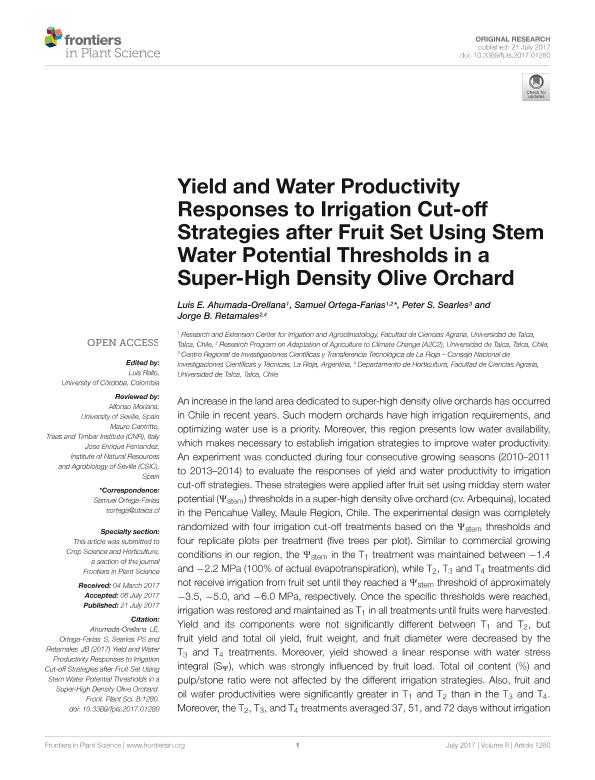Mostrar el registro sencillo del ítem
dc.contributor.author
Ahumada Orellana, Luis E.
dc.contributor.author
Ortega Farías, Samuel
dc.contributor.author
Searles, Peter Stoughton

dc.contributor.author
Retamales, Jorge B.
dc.date.available
2018-04-05T17:16:50Z
dc.date.issued
2017-07
dc.identifier.citation
Ahumada Orellana, Luis E.; Ortega Farías, Samuel; Searles, Peter Stoughton; Retamales, Jorge B.; Yield and Water Productivity Responses to Irrigation Cut-off Strategies after Fruit Set Using Stem Water Potential Thresholds in a Super-High Density Olive Orchard; Frontiers Research Foundation; Frontiers in Plant Science; 8; 1280; 7-2017; 1-11
dc.identifier.issn
1664-462X
dc.identifier.uri
http://hdl.handle.net/11336/40901
dc.description.abstract
An increase in the land area dedicated to super-high density olive orchards has occurred in Chile in recent years. Such modern orchards have high irrigation requirements, and optimizing water use is a priority. Moreover, this region presents low water availability, which makes necessary to establish irrigation strategies to improve water productivity. An experiment was conducted during four consecutive growing seasons (2010?2011 to 2013?2014) to evaluate the responses of yield and water productivity to irrigation cut-off strategies. These strategies were applied after fruit set using midday stem waterpotential (PHIstem) thresholds in a super-high density olive orchard (cv. Arbequina), located in the Pencahue Valley, Maule Region, Chile. The experimental design was completely randomized with four irrigation cut-off treatments based on the PHIstem thresholds and four replicate plots per treatment (five trees per plot). Similar to commercial growing conditions in our region, the PHIstem in the T1 treatment was maintained between -1.4 and -2.2 MPa (100% of actual evapotranspiration), while T2, T3 and T4 treatments did not receive irrigation from fruit set until they reached a PHIstem threshold of approximately -3.5, -5.0, and -6.0 MPa, respectively. Once the specific thresholds were reached, irrigation was restored and maintained as T1 in all treatments until fruits were harvested. Yield and its components were not significantly different between T1 and T2, but fruit yield and total oil yield, fruit weight, and fruit diameter were decreased by the T3 and T4 treatments. Moreover, yield showed a linear response with water stress integral (Sphi), which was strongly influenced by fruit load. Total oil content (%) and pulp/stone ratio were not affected by the different irrigation strategies. Also, fruit and oil water productivities were significantly greater in T1 and T2 than in the T3 and T4. Moreover, the T2, T3, and T4 treatments averaged 37, 51, and 72 days without irrigation which represented 75?83, 62?76, and 56?70% of applied water compared with T1, respectively. These results suggest that using the T2 irrigation cut-off strategy could be applied in a super-high density olive orchard (cv. Arbequina) because it maintained yields, saving 20% of the applied water.
dc.format
application/pdf
dc.language.iso
eng
dc.publisher
Frontiers Research Foundation

dc.rights
info:eu-repo/semantics/openAccess
dc.rights.uri
https://creativecommons.org/licenses/by/2.5/ar/
dc.subject
Olea Europaea
dc.subject
Deficit Irrigation
dc.subject
Plant Water Status
dc.subject
Yield Components
dc.subject
Total Oil Yield
dc.subject.classification
Agricultura

dc.subject.classification
Agricultura, Silvicultura y Pesca

dc.subject.classification
CIENCIAS AGRÍCOLAS

dc.title
Yield and Water Productivity Responses to Irrigation Cut-off Strategies after Fruit Set Using Stem Water Potential Thresholds in a Super-High Density Olive Orchard
dc.type
info:eu-repo/semantics/article
dc.type
info:ar-repo/semantics/artículo
dc.type
info:eu-repo/semantics/publishedVersion
dc.date.updated
2018-04-05T13:44:20Z
dc.journal.volume
8
dc.journal.number
1280
dc.journal.pagination
1-11
dc.journal.pais
Suiza

dc.journal.ciudad
Lausana
dc.description.fil
Fil: Ahumada Orellana, Luis E.. Universidad de Talca; Chile
dc.description.fil
Fil: Ortega Farías, Samuel. Universidad de Talca; Chile
dc.description.fil
Fil: Searles, Peter Stoughton. Consejo Nacional de Investigaciones Científicas y Técnicas. Centro Regional de Investigaciones Científicas y Transferencia Tecnológica de La Rioja. - Universidad Nacional de La Rioja. Centro Regional de Investigaciones Científicas y Transferencia Tecnológica de La Rioja. - Universidad Nacional de Catamarca. Centro Regional de Investigaciones Científicas y Transferencia Tecnológica de La Rioja. - Secretaría de Industria y Minería. Servicio Geológico Minero Argentino. Centro Regional de Investigaciones Científicas y Transferencia Tecnológica de La Rioja. - Provincia de La Rioja. Centro Regional de Investigaciones Científicas y Transferencia Tecnológica de La Rioja; Argentina
dc.description.fil
Fil: Retamales, Jorge B.. Universidad de Talca; Chile
dc.journal.title
Frontiers in Plant Science
dc.relation.alternativeid
info:eu-repo/semantics/altIdentifier/url/http://journal.frontiersin.org/article/10.3389/fpls.2017.01280/full
dc.relation.alternativeid
info:eu-repo/semantics/altIdentifier/doi/http://dx.doi.org/10.3389/fpls.2017.01280
Archivos asociados
